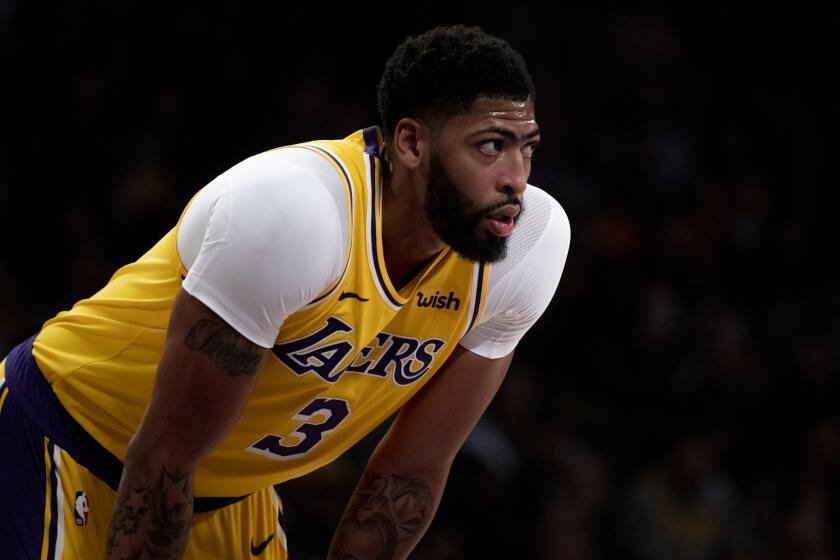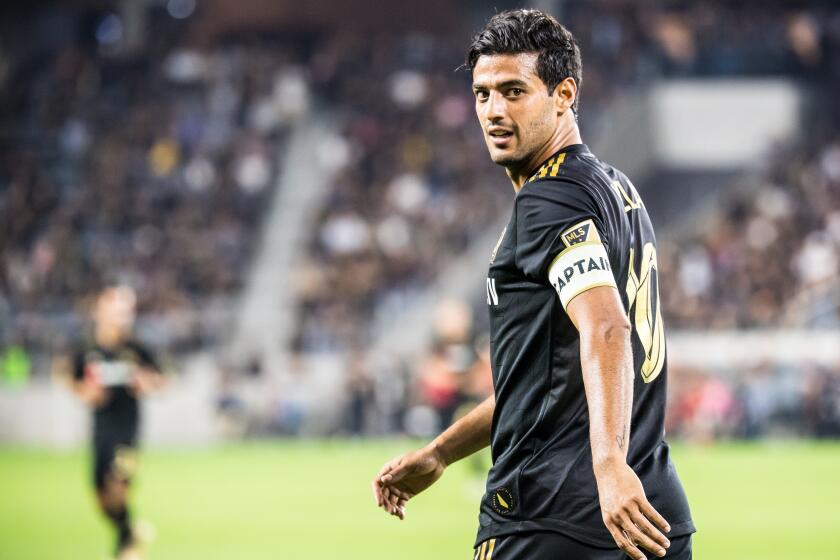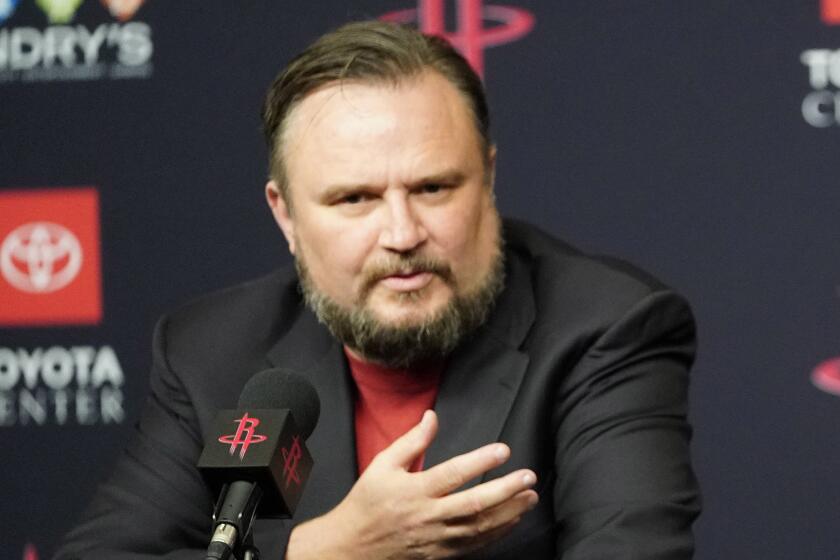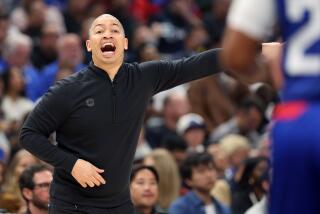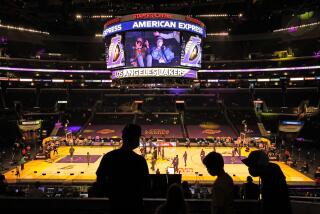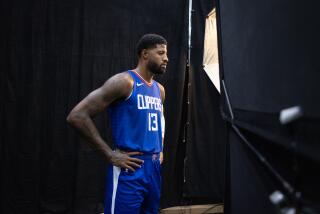Will COVID-19 burst NBA’s Orlando bubble? Our Lakers and Clippers experts discuss
- Share via
Photographer Andy Bernstein has been shooting the Los Angeles Lakers for 38 years and the Clippers for the 35 years since they moved to L.A. On Tuesday, Bernstein and the Times announced that they will co-produce his Legends of Sport podcast. For the next 16 weeks, the podcast will focus, season willing, on the NBA and its bubble experiment. Later this summer, Bernstein will travel to Orlando to shoot the postseason. Also on site in Orlando, and for the July 30 Lakers-Clippers re-opener, will be Lakers beat writer Tania Ganguli and Clippers beat writer Andrew Greif, who joined this week’s podcast.
You can listen to the entire podcast here.
Andy Bernstein: Andrew, you wrote a story recently about what the day-to-day life of an NBA player would be like in Orlando. Right? It was fascinating. What do you think the biggest challenges are going to be for the players and coaches? It could be three and a half months in Orlando.
Andrew Greif: Landry Shamet, the guard, and Coach Doc Rivers, they both mentioned something that a lot of players have brought up which is the mental side of things. Obviously, there are so many concerns with physical ability of the players on coaches if you think about the potential for injuries after the long layoff. Or obviously, COVID-19, that’s the whole reason we are even doing this.
But the idea of it, there are only a few golf courses on that Disney campus. There are only so many activities you can do, only so many DJ sets you can probably attend in the players’ lounge. And there’s a real sense cabin fever could set in no matter the incentive. Obviously, the Clippers have this opportunity to advance to the first, not only NBA finals in the franchise history, but the first Western Conference finals. They’ve never even been there.
Andy Bernstein: I’ve been covering them for 35 years. I get it.
Andrew Greif: Even with all that incentive, there is still going to be on these off days just an enormous amount of ‘What do I do today?’ That’s something that players, even though these regulations and policies have been out here for now almost two weeks or so, I think players are still grappling with that. Like, what’s it really going to look like in the middle of September?
Lakers forward Anthony Davis and coach Frank Vogel are confident the Lakers can continue their dominant play and a run at the NBA title despite long break.
Andy Bernstein: If you were to put yourself in Adam Silver’s shoes, like right now before this whole thing started, what would be your top three concerns?
Tania Ganguli: I think the top concern is that the situation in Florida gets so bad that you can’t possibly create a safe environment. We talked to Rob Pelinka [recently], and he was saying that the idea is that they are going to create a space that’s safer than the outside world. That’s fine, but they are going to have several people coming in and out of the bubble, including Adam Silver. There are going to be hotel workers. It can’t be a truly secluded space.
In L.A. the virus is making a big comeback because things are open. Things are open in Florida. The NBA at one point was saying that in order to return they’ll have to see cases going down. I think like a lot of people in society, they just got tired of waiting for that to happen and have tried to figure it out. The protocols that they have put in place are very strict, as you read in Andrew’s story. It’s not going to be easy to do anything when they’re out there.
But even with that, we’ve seen the MLS try to create a bubble and they’ve had Coronavirus cases inside the bubble from players who initially tested negative and then once the virus incubated tested positive a few days later.
Here’s a list of some notable athletes who have decided not to take part in the sports’ restart amid the coronavirus crisis.
Andrew Greif: I think the NBA, rightfully so, and the players have a lot of goodwill toward each other and they work very well together. There’s a real amount of cooperation that happens that a lot of leagues do not have. But you saw some of these players grappling with whether they wanted to play or not because of the social justice issues. They feel like they want to be heard in Orlando. They want to feel like they’re not just going there and leaving some of the protest movement, diverting attention away from it. I would be worried if players go down there and they say, “We thought we were going to have a wider platform. We thought we’d have all these different ways we could get our voices heard.” And then for that not to come true.
I don’t know that that’s going to happen. You’ve seen the way the NBA has bent over backwards. They say that their core goal of this is to make sure that social justice is at the forefront. But I think they have such a good working relationship, for that relationship to go on in the future you’d want players to leave their thinking the NBA was in lockstep with us and not thinking the other way.
Andy Bernstein: Rob Pelinka mentioned [last week] that he wasn’t sure who was going to be on his final roster. Avery Bradley chose to opt out for family reason. So, to replace him they brought in JR Smith. So, how do you view that? Is it going to help them, or does it really matter?
Tania Ganguli: From a basketball perspective it’s tough for them to lose Avery. He was so important to their defensive identity. They have a lot of guys on their team who have the capability to be really good defenders. For some reason, having Avery out there was such a big boost for them. I mean, I shouldn’t say for some reason. It’s because of his tenacity defensively.
But I was really struck by in talking with…we’ve done…as of recording, we’ve done three Zoom calls this week—with Rob Pelinka and Frank Vogel and Alex Caruso. I was really struck by the empathy that everybody had for Avery’s situation. He’s got a young son with a respiratory condition. They truly were understanding of him wanting to make this decision for the sake of his family. But it’s definitely going to be tough for them to replace him. Kentavious Caldwell-Pope was somebody that filled in when Avery was hurt.
Amid players and team staff testing positive for COVID-19, the NBA heads to Orlando knowing its setup for the season might not be good enough.
I think one other thing that helps, I wrote about this week, is that they’re not going to have several weeks to figure out what to do. You know, when you lose somebody to an injury during the basketball season, it’s so sudden. There’s no time to really figure out what you’re going to do. Now, they’re going to be going into the situation knowing that they don’t have this player and they’re going to be able to prepare for it. You know, J.R. Smith is somebody that they tried to sign back in March. Not tried to sign, excuse me, considered signing. They brought him in for a workout and decided to sign Dion Waiters instead. And he’s somebody that’s very familiar with LeBron, obviously, which I think will help his transition onto this team.
Andy Bernstein: Andrew, the Clippers. They have the second-best record in the West, right? But I didn’t see Paul George and Kawhi play enough together to really get a strong opinion like yeah, they can really go for the ring. How do you feel about it?
Andrew Greif: They didn’t really play together until the middle of November. And then from there on it was fairly hit or miss because Kawhi would rest on back-to-backs and then Paul had hamstring issues in January and then again the next month. It really wasn’t until, I would say, after the signing of Reggie Jackson in late February, when you really got a window—and it’s basically a 10- or 12-game window—of what the Clippers could really be. And I think central to that is seeing how Kawhi and Paul play together.
So for two weeks, it seemed like there was a better sense of their combined potential. Not just of how they could play it when they were at top gear, because of course we know that they can go for 40 apiece as they did in December against Minnesota. But just seeing how they interact with the rest of the teammates, allowing guys to get to their spots while not sacrificing their ability to attack. I saw, for once, all the gears click into place. And they won, I believe it was, seven of their last eight before everything shut down. They were playing really well.
And I think that Kawhi is still kind of the number one on that team. But Paul, you were seeing him get really comfortable playing off the ball, finding his spot. I think his experience playing with Russell Westbrook in Oklahoma City primed him for this because he’s not the career-long, first option who now has to play second banana. He knows how to do this.’
The full library of L.A. Times podcasts can be found here.
More to Read
Go beyond the scoreboard
Get the latest on L.A.'s teams in the daily Sports Report newsletter.
You may occasionally receive promotional content from the Los Angeles Times.
